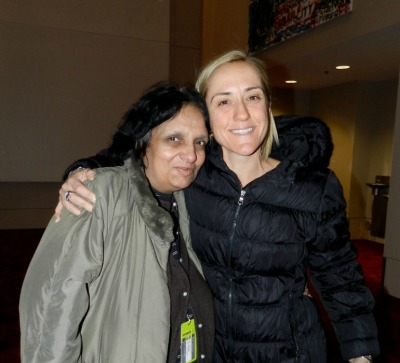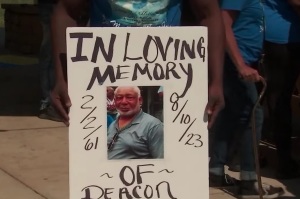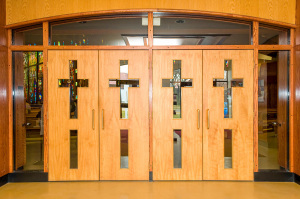Human Trafficking in India; My Family's Personal Encounter
"Indifference is not an option." "God wants to use rescued people to rescue people." "Bring this darkness into the light." "Raise your voice for freedom." These are all phrases we heard along with more than 45,000 college students who packed the Georgia Dome for the Passion 2012 Conference in Atlanta last year, as prominent Christian leaders used their platform to highlight the horrors of modern-day slavery. It was here that we first developed a distinct awareness of the 27 million people in bondage to different forms of slavery worldwide.

We were shocked to learn that there are more slaves in the world today than at any time in history, and slavery's various expressions include human trafficking, sex slavery, descent-based slavery, forced labor, bonded labor, and child labor. We heard stories that spanned age, gender, and location, including descriptions of young girls forced into sex trafficking here in Atlanta and in major cities around the world, and older men trapped in cycles of slavery forced to work in brick yards and rock quarries for generations. In particular, human trafficking is a global humanitarian crisis which crosses continental divides and social boundaries, permeating commercial enterprises, infiltrating homes, and charting the lives and livelihoods of millions across the globe.
Right after the conference ended, as we were in the elevator leading to the parking lot, we happened to meet Christine Caine, founder of The A21 Campaign, who had spoken at the conference about the crisis of modern-day slavery. We thanked her for her brave efforts fighting global human trafficking, and mentioned that we were gaining a greater awareness of the problem in India. With authority and anguish in her voice, Caine responded, "India is one of the worst countries when it comes to human trafficking." This tragic reality is the result of generational indentured labor practices, from rice mills and brick factories to booming brothels and the mass transfer of girls for domestic services in urban city centers. In fact, many aspects of slavery and trafficking in India today are often ignored or even accepted as legitimate practice.
Just a few weeks after Passion 2012, we traveled to India to visit relatives and friends. Literally as soon as we arrived from the airport at the house where we would be staying in an affluent suburban community, we sensed an atmosphere of tension and anxiety. We looked at the face of the household maid, usually radiant and ready to serve, and noticed her distressed and fearful countenance. With tears in her eyes, she told us that two of her cousins, who had been traveling from their rural mountain home in eastern India, were enticed by an organization to relocate to a big city where they would get well-paying jobs as maids in prosperous homes. On the way, as the girls were waiting at a railway station to be picked up by relatives, they were both abducted. The police were able to rescue one of the girls (who now works for a wealthy family in the city), but the other girl was still missing (to this day, there has been no explanation of her whereabouts, and over one year later the family is still grieving).
At the Passion 2012 Conference we were troubled by all the information about human trafficking, but we never expected our first personal encounter in India to illustrate the grim reality of this massive problem.
The young girl who works for an affluent family is fortunate to be in a home where her personhood and dignity are respected, but many others like her are not as fortunate. Often, these girls migrate from their distant village homes in search of a better life, especially when their impoverished parents cannot provide for them, but there is absolutely no guarantee of the life or the lifestyle they will be subjected to at their new destinations.

In recent years, with the influx of multinational corporations in India and with greater prosperity in urban city centers, there has been a growing market for domestic help, especially for young girls who are seen as versatile in their roles as housekeepers, cooks, and nannies. They are brought to the big cities by agents who use their personal contacts in rural communities to lure the girls to the city, promising them relief and refuge from their desperate situations. This is a lucrative trade for the agents, a seemingly immediate solution for the families, and a boon to the affluent householders, who, for a small fee can have the services of a young girl on demand. There always seems to be a ready availability of these girls, and all a client must do is call the agent, provide specifications of the type of girl they need (in terms of age, skills and salary), and it appears that agencies always have a custom-ordered human product ready for the customer. As we traveled throughout India over the past year, we interacted with numerous women of all ages who shared excruciating stories of harassment, abuse, and exploitation resulting from this practice.
In our previous tours across India, we saw many brick factories, rice mills, iron foundries, and a variety of commercial enterprises where families have served for generations. We once assumed that it was simply their family trade with personal ownership. Now, however, with the growing awareness of the endemic state of human trafficking, we realize that multitudes are subjected to the bondage of generational slavery. We recently visited underprivileged people groups in rural areas, from where most of the victims of human trafficking originate, and also observed the urban areas which are their ultimate destination. Based on our firsthand encounters, we have a clearer understanding of the personal, social and financial dynamics that drive the human trafficking industry.
When Christine Caine spoke at Passion 2012, she said, "A million is a statistic until you meet one. Then they are a person." We now understand exactly what she meant. It's true that "27 million people in slavery" sounds so distant, because sheer numbers are faceless and can be easier to ignore. But when you hear one heart wrenching story or see one face personally affected by this injustice, you are motivated to take action and speak out on behalf of those who do not have a voice. That is what we experienced in India, as we went beyond the rhetoric and encountered the harsh reality of human trafficking.
The "End It Movement," which launched at Passion 2013, is a campaign to raise awareness of modern-day slavery and bring freedom to the 27 million slaves around the world by partnering with a wide array of organizations and individuals dedicated to various aspects of this fight (http://www.enditmovement.com/). On this "Shine a Light on Slavery Day," we want to be two of the millions of voices who desperately cry out for the restoration of human dignity and freedom endowed on each of these, who – just like us – are made in the image of our Maker. Scripture speaks repeatedly of the freedom we have been given through Jesus Christ, and challenges us to live out our days in light of how our Savior rescued us. As the apostle Paul states in Galatians 5:1, "It is for freedom that Christ has set us free. Stand firm, then, and do not let yourselves be burdened again by a yoke of slavery." We pray that the End It Movement will be a dynamic force to challenge and change systemic problems, promote justice where there is injustice, and bring about lasting freedom and transformation in our generation. And we hope that you will join in this movement and raise your own voice for the cause of freedom.




























